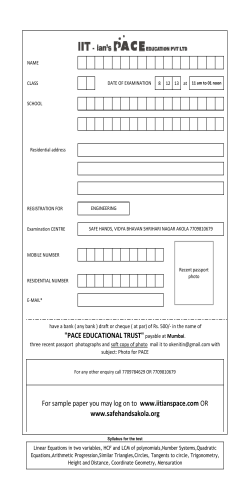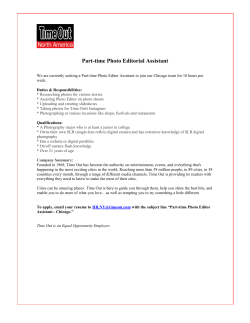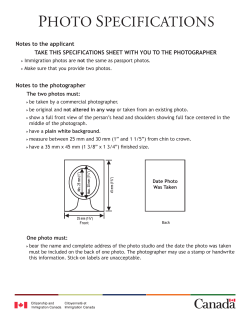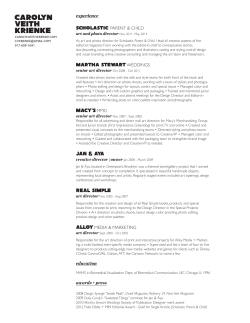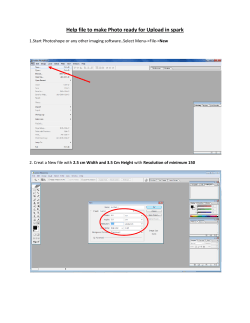
Blackland Prairie Field Guide - North Texas Master Naturalist
What is a Prairie? BLACKLAND PRAIRIE GUIDE TO 100 COMMON SPECIES The land you’re standing on now in North Texas is in an area called the Blackland Prairie. In the past, an uninterrupted sea of waist-high grasses covered the land. When Europeans colonized the area, they replaced the grasses with fields of crops, and planted trees to shelter their homes. On the prairie, naturally occurring wildfires kept trees from establishing on the prairie. Texas settlers started putting out these fires to protect their homes and livestock, and the landscape changed. This booklet tells about • plants and animal species original to the Blackland Prairie • some newly introduced “invasive” species endangering original native species • where you can find these plants and animals • how you can get involved preserving the natural diversity of our area. Acknowledgements Special thanks to the sponsors of Texas Master Naturalists: Texas Parks and Wildlife http://tpwd.texas.gov/ Texas A&M Agrilife Extension http://agrilifeextension.tamu.edu/ Become involved today! Join the North Texas Master Naturalists in education, outreach, and service. http://public.ntmn.org/about-the-master-naturalistprogram Blackland Prairie Map (above) from TP&W Photo on cover: Brad Criswell Purple Coneflower (Echinacea purpurea) Native perennial with cone-shaped flower head and drooping purple to lavender petals on a single stem 2-5 feet tall. Popular garden plant that is easily grown. Photo: Public Domain Indian Paintbrush (Castilleja indivisa) Annual blooms Mar.-May. Red and orange paintbrush like spiky blooms. Semi-parasitic, its roots grow into roots of other plants to obtain more nutrients. Grows 12-18 inches tall. Found in prairies, meadows, and roadsides all over TX. Photo: Mahalie Stackpole Indian Blanket (Gaillardia pulchella) Annual blooms MayAug. Showy flower red flower heads tipped with yellow. Found in dry plains and open areas all over TX. Photo: U.S. Fish and Wildlife Service Butterfly Weed (Asclepias tuberosa) Perennial blooms May-Sept. Small orange to yellow blooms. This member of the milkweed family is the larval food of Queen and Monarch butterflies. Found in the eastern 2/3 of TX in prairies, open woodlands or hillsides. Rare in the Hill Country. Photo: Derek Ramsey Brown-eyed Susan (Rudbeckia hirta) Perennial blooms MaySept. Yellow ray flowers encircle a head of brown or black disc flowers. Found all over TX. Photo: Shelby Raymond Cardinal Flower (Lobelia cardinalis) Perennial blooms Jul-Sept. Showy red blooms. Found all over TX in moist to wet soil. Pollinated by hummingbirds because of the blooms’ tubular shape. Photo: Dr. Thomas G. Barnes Mexican Hat (Ratibida columnaris) Perennial blooms May-Oct. Red and yellow sombrero shaped blooms. Found in prairies, meadows and roadsides throughout TX. Photo: Wing-Chi Poon Drummond Phlox (Phlox drummonii) Annual blooms Mar.-Jun. White, red, pink or purple blooms. Found in grasslands and open woodlands in east and central TX. Photo: Tim Ross Wine Cup Mallow (Callirhoe pedata) Perennial blooms Mar.-May. Dark red to pink cup-shaped white blooms with white centers. Found in open woodlands and on rocky hills in shrublands and thickets. Photo: Lee Page Prairie Verbena (Verbena bipinnatifida) Annual or short lived perennial blooms Feb.-Oct. Pink to purple blooms. Common throughout south-central to north-central TX and the panhandle. Photo: Pauline Schafer Where can I experience Blackland Prairie today? Following are some places you can go to discover, find, and learn near you: Cedar Ridge Preserve 7171 Mountain Creek Parkway, Dallas TX http://audubondallas.org/cedarridge.html Lewisville Lake Environmental Learning Area Jones and Kealy Street, Lewisville, TX http://llela.unt.edu/ White Rock Lake Conservancy E. Lawther Drive, Dallas, TX http://www.whiterockdallas.org/visit/nature/ Connemara Conservancy 300 Tatum Rd., Allen, TX http://connemaraconservancy.org/wordpress/meadownature-preserve/ The Heard Museum 1 Nature Place, McKinney, TX http://www.heardmuseum.org/nativeplantgarden Pink Evening Primrose (Oenothera speciosa) Perennial blooms Feb.-Jul. Pink or white four-petaled blooms. Spreads via both runners and seeds Native to all grasslands throughout TX. Each flower lasts only a single day. Photo: Louisiana State University Blazing Star (Liatris mucronata) Perennial flower of prairies blooms late summer to fall. Feathery purple flowers on tall spike, narrow linear leaves dense on stem. Photo: Clarence A. Rechenthin, hosted by the USDA-NRCS PLANTS Database Photo: Brad Criswell Prairie Glossary Annual - plants living for a year or less, reproducing by seed Carnivore - classification of animal that only eats other animals Deciduous - classification of broadleaf trees that shed leaves annually Diurnal - active during the daytime Evergreen - classification of plant that has leaves yearround Herbivore - classification of animal that solely eats vegetation Invasive - species that tend to spread prolifically and undesirably or harmfully. Leaf: a leaf may be single, or composed of multiple leaflets Silver Spotted Skipper (Epargyreus clarus) Commonly seen March - October. Rapid flight pattern. White spots on underside of hind wings. Caterpillar host plants: Various Locusts; Clovers; Kudzu; Wisteria. Photo: Dale Clark – Dallas County Lepidopterist’s Society Cabbage White (Pieris rapae) Seen everywhere throughout metroplex February – November. Caterpillar host plants: Mustards; Nasturtium; Cabbages; Cruciferous Vegetables. Photo: Dale Clark – Dallas County Lepidopterist’s Society Dainty Sulphur (Nathalis iole) Seen throughout metroplex February – late November. Caterpillar host plants: Various Dogweeds; Cultivated Marigolds; Common Sneezeweed. Photo: Dale Clark – Dallas County Lepidopterist’s Society Monarch (Danaus p. plexippus) Commonly seen throughout the metroplex March – November. Caterpillar host plants: Various Milkweed. Photo: Dale Clark – Dallas County Lepidopterist’s Society Viceroy (Limenitis a. archippus) Commonly seen throughout metroplex April – October. Best seen by lakes/creeks where willows and cottonwoods are prevalent. Caterpillar host plants: Various Willows; Various Poplars. Photo: Dale Clark – Dallas County Lepidopterist’s Society Goatweed Leafwing (Ananea andria) Commonly found in disturbed areas and fields throughout the metroplex February – November. Caterpillar host plants: Various Crotons; Doveweed. Photo: Dale Clark – Dallas County Lepidopterist’s Society Leaflet: a small component of an entire leaf Migrant: moves regularly with the seasons to follow food supply Native - species original to an area Noctural - active at nighttime Omnivore - classification of animal that eats a varied diet of plants an other animals Palmate: arranged in the shape of a hand Perennial - plants that persist for several years, and have new growth each year Pinnate: arranged in a shape like a feather Resident: stays in one area year-round Tendril: specialized stem or leaf with a threadlike shape used by climbing plants for support and attachment American Snout (Libytheana carinenta bachmanii) Commonly seen throughout the metroplex February – November. Caterpillar host plants: Sugarberry; NetLeaf Hackberry. Photo: Dale Clark – Dallas County Lepidopterist’s Society Olive Juniper Hairstreak (Callophrys gryneus castalis) Can be seen March – October. Always found near host plant or by tapping bark. Caterpillar host plants: Eastern Red Cedar; Red-Berry Juniper. Photo: Dale Clark – Dallas County Lepidopterist’s Society Common Checkered Skipper (Pyrgus communis) Commonly seen throughout metroplex February – November. Especially common in low growth habitat and disturbed areas. Caterpillar host plants: Hollyhock; Various Mallow. Photo: Dale Clark – Dallas County Lepidopterist’s Society Variegated Fritillary (Euptoieta claudia) Seen throughout metroplex February – November. Intolerant of extreme cold. Caterpillar host plants: Yellow or Blue Passionvine; Various Flax. Photo: Dale Clark – Dallas County Lepidopterist’s Society Hackberry Emperor (Asterocampa c. celtis) Commonly seen throughout metroplex midlate April – first frost. Caterpillar host plants: All Hackberry trees. Photo: Dale Clark – Dallas County Lepidopterist’s Society Common Buckeye (Junonia c. coenia) Seen throughout metroplex March – November. Caterpillar host plants: Various Plantains; Paintbrush; Snapdragon vines. Photo: Dale Clark – Dallas County Lepidopterist’s Society American Beaver (Castor Canadensis) Diurnal, semi-aquatic. Average size 30-60 lbs. Has dark brown to golden coat and webbed hind feet. Uses large, orange-tinted incisor teeth to feed on inner bark of trees and shrubs. Bears 1-8 young called kits. Photo: Steve Hersey Bobcat (Lynx rufus) Mainly nocturnal but may come out before dusk. Medium sized, brown and gray coat with dark spots, tufts on ear tips. Short tail, long legs & large feet. Diet of small animals and birds. Photo: Texas Parks & Wildlife Common Raccoon (Procyon lotor) Nocturnal omnivore, gray to brown fur overall; black mask around its eyes, and rings around its tail. Its paws resemble human hands. Adept climbers. Found in woods and urban environments. Photo: Dave Menke Coyote (Canis latrans) Lanky, largeeared dogs, 3-4 ft. long, 30 lbs. Upperparts variable, usually brownish; belly/throat are pale. Tail held down when running. Common in all habitats including suburban areas. Photos: Texas Parks and Wildlife Eastern Cottontail (Sylvilagus floridanus) Year-round resident. Large ears, upperparts are heavily furred in brown/gray; belly/undertail furred in white. Widely distributed in a variety of habitats.Photo: U.S. Fish and Wildlife Service Fox Squirrel (Sciurus niger) Largest species of tree squirrel in North America. Often found among oak, hickory, walnut, pine, and other trees. Highly adaptable and common in urban areas. Photo: Pat Durkin Ringtail (Bassariscus astutus) Nocturnal, reclusive omnivore. Member of the raccoon family. Weighs 3 lbs at maturity. Long, black & white striped tail. Seldom seen, though common from E. TX, westward. Photo: Public Domain Invasive and Non-Native Species These non-native species are commonly seen in the Blackland Prairie Bastard Cabbage (Rapistrum rugosum) Invasive: This member of the mustard family has yellow flowers on a tall many branched stem 1-5 feet. Non-native crowds out all other flowers. Photo: Mark Simmons, Lady Bird Johnson Wildflower Center Striped Skunk (Mephitis mephitis) Largely nocturnal omnivore. Highly social and often dens together. Black fur with white stripe down flanks and sides of tail. Produces strong musk spray as defense and has few natural predators. Found in wooded or brushy areas, insects form bulk of their diet. Photo: TP&W Virginia Oppossum (Didelphis virginiana) North America’s only marsupial. This omnivorous scavenger is found in woods and urban environments. Climbs trees easily with sharp claws and a prehensile tail. Photo: Orsulak, USFWS Black Tailed Jackrabbit (Lepus californicus) Third largest hare in North America, a vegetarian and most active at dusk and night. Does not hibernate or migrate. Prefers the high visibility of open areas and pasture land to spot predators. Lifespan in the wild is eight years. Photo: Texas Parks & Wildlife Gray Fox (Urocyon cinereoargenteus) Secretive omnivore is nocturnal or crepuscular (most active in evening and early morning). Salt and pepper coat, white throat and underbelly and black tipped tail. Mating season Dec.-Apr., litters appear in April. Photo: Texas Parks & Wildlife White Tailed Deer (Odocoileus virginianus) Long tail is brown on top and with distinct white and fringed underside. Male antlers have small vertical tines off the single main stem. Variety of forested habitats. Photo: Texas Parks & Wildlife Pincushion (Scabiosa atropurpurea) Annual. Blue or purple blooms. Invasive, tends to crowd out other flowers. Native to Africa. Photo: Christian Ferrer European Starling (Sturnus vulgaris) Introduced in 1890 from Europe; aggressive and destroys eggs of native cavity nesting birds. Year round resident; black iridescent purple/green all over with white speckles; yellow long pointed beak in summer & gray in autumn. Very vocal. Photo: Dr.Thomas G. Barnes - U.S. Fish and Wildlife Service Chinese Privet (Ligustrum sinese) Evergreen shrubs with opposite leaves. Many fragrant white flowers in April- June. Fruit is berries that begin green, ripening to dark purple to black. Photo Joseph Wong Kai Yan OTexas State SymbolsO These Texas symbols are commonly seen in the Blackland Prairie. O Texas Bluebonnet (Lupinus texensis) State Flower of Texas bears fragrant stalks of indigo and white flowers in the spring. Leaves are palmate, composed of 7-10 leaflets. Stem and undersides of leaflets are hairy. Like other members of the bean family, bears fruit in the form of a seed-filled pod. Photo: Dr. Thomas G. Barnes O Northern Mockingbird (Mimus polyglottos) State bird of Texas is aptly named - it means “many-tongued mimic”. Imitates many other area birds’ calls, singing triplets of one call before switching rapidly to another. Gray bird with long tail and bright white patches on dark wings. Photo: Texas Parks & Wildlife O Nine Banded Armadillo (Dasypus novemcinctus) Prefers warm, rainy environments throughout the Americas. Covered in bony armored plates. Mainly nocturnal. Insectivore. Can jump up to 4 vertical feet when frightened. Photo: Public Domain O Pecan (Carya illinoensis) A large deciduous shade tree with pinnately compound leaves grows to 90 ft tall. Found in bottomlands near streams and rivers. Its fruit is a small sweet nut that ripens in Sept and Oct. The Texas state tree. Photo: Pauline Schafer and Brad Criswell Painted Bunting (Passerina ciris) This small bird spends spring and summer in Texas eating grass seed. Has twittering call. Female plumage is dull green. The male, with blue head, red underside, and green back is rightfully called the most beautiful bird in North America. Photo: Joyce Phillips Harris’s Sparrow (Zonotrichia querula) Largest of all sparrows; spends winter among tallgrass prairies & urban birdfeeders. Winter color is tan; black patch from crown to breast; white under parts with streaked sides. Breeds only in Canada. Has a very pleasant song. Photo: Robert Nunnally Eastern Meadowlark (Sturnella magna) This robust brown/buff striped bird has bright yellow from chin to belly with a distinct black V on the chest; has white outer tail feathers. Found year round sitting on fence posts and along roadsides. Eats insects, grains & seeds. Photo: Matthew Paulson Eastern Kingbird (Tyrrannus tyrannus) Found during summer months. Gray with black head & tail, white underparts. White band on tip of tail when flying. This feisty flycatcher enjoys harassing hawks & other threats. Named “king of the tyrants”. Will hover to pick up insects. Photo: Kelly Colgan Azar Scissor-tailed Flycatcher (Tyrannus forficatus) This striking 14” long flycatcher will easily capture your attention with its long scissor like tail as they are seen perching along roadways or capturing food on the wing. The salmon sides stand out from the dark gray wings and buff breast. Photo: U.S. Fish and Wildlife Service Eastern Bluebird (Sialia sialis) The eastern bluebird is a small bird found in open woodlands, farmlands, and orchards. The bright-blue breeding plumage of the male, easily observed on a wire or open perch, makes this species a favorite of birders. Photo: William H. Majoros Northern Flicker (Colaptes auratus) The northern flicker which reaches a height of 12 to 13 inches is the only member of the woodpecker species with a brown-colored back and feeds on the ground. The male can be distiguished by the red or black moustachial stripe. Photo: U.S. Fish and Wildlife Service Dickcissel (Spiza americana) Dickcissels have a large pale bill, a yellow line over the eye, brownish upperparts with black streaks on the back, dark wings, a rust patch on the shoulder and light underparts. Adult males have a black throat patch, a yellow breast and grey cheeks and crown. Photo: Kelly Colgan Azar American Kestrel (Falco sparverius) America’s smallest falcon feasts on insects in TX year-round. Very colorfulblue on crown & edges of wings; red on breast and back, with rows of dark spots all over. Signature vertical stripes underneath eye and ear. Photo: U.S. Fish and Wildlife Service Northern Harrier (Circus cyaneus) Slender, long-tailed hawk with small head and beak. Often winters in TX. Males are gray with black tips on wings. Females are brown and have dark streaks on underside of wing and tail. Photo: Don McCollough Red-tailed Hawk (Bueto jamaicensis) Large prairie predator can be found soaring overhead year round. Brownish-tan head and wing, white belly with band of black spots, reddish tailfeathers. Will feed on mammals, birds, snakes, and carrion. Photo: U.S. Fish and Wildlife Service Wild Turkey (Meleagris gallopavo) Bulky, brown omnivore found in North TX all year; will nest in tall grass during breeding season (March-July). Bare neck with loose red skin and blue cheeks. Attracts mates with its snood, the fleshy sac hanging from face. Photo: U.S. Fish and Wildlife Service Yellow Garden Spider (Argiope aurantia) 1” female with black and yellow abdomen, usually hanging upside-down on the zig-zag of silk in the center of her round web, waiting for insects and small lizards. Males are smaller, inconspicuous brown. Photo: Spencer Bawden Praying mantis (Stagmomantus carolina) Predator of insects and each other; have compound eyes, and bent front legs which are used to grasp their prey. Females have a larger abdomen than males; their egg sacs may hold 200 young. Photo: Kaldari Variegated meadowhawk dragonfly (Sympetrum corruptum) Perches with his wings horizontal, like all dragonflies, usually on the tips of grasses. Male 1” with reddish-pink bands on his abdomen. Females gray, with yellow on her abdomen. Photo: Jim Kennedy Harvester Ant (Genus Pogonomyrmex) Collectors of seeds which are hidden in underground granaries in the community nest. Broad head larger than abdomen. Reddish to black in color; can inflict a painful sting. Photo: Public Domain Texas Bark Scorpion (Centruroides vittatus) Rarely over 2.5”, pale yellow with 2 darker brown stripes down his side. Found under rocks & debris, in old sheds. Preys on insects; is eaten by birds, reptiles, mammals. Sting is painful but seldom deadly. Photo: Texas A&M AgriLife Extension Lady bug (Hippodamia convergens) White band around her head,13 black spots on red shell. Larvae and adults eat ahpids & insects. Larvae are black with orange spots with a long abdomen and no wings. Releases a nasty chemical from her legs when attacked. Photo: Walter Siegmund Pill Bug Roly-Poly (Armadillidium vulgare) This crustacean is a favorite of children; rolls up in a ball when threatened. Can live for two years and nurtures its young. Photo: Joseph Sparks Texas Grassland Cicada (Cicadetta texana) A small to medium cicada that possesses a pair forming song system where the male alternate short songs with short flights to a new perch Photo: Sheryl Smith-Rodgers Robber fly (Asilidae) A powerfully built, bristly fly with a short, stout proboscis enclosing the sharp, sucking tongue. Aggressive predatory habits. Photo: Texas Parks and Wildlife Department Virginia wild rye (Elymus virginicus) One of the few native prairie grasses that thrives in wooded areas. The drooping seedhead has a beige wheat-like appearance with long hairs emerging from the florets. Grows to 2 1/2 ft tall. Photo: Public Domain Scribner’s panic grass (Panicum oligosanthes) This cool weather grass blooms as early as May, maturing a seedhead of multiple spikelets bursting from a central clasp on the stem. Grows up to 18 inches tall. Photo: Maya Ogren Mead’s caric sedge (Carex meadii) Unique to the northeastern tip of the Blackland prairie, this small grass-like plant is a sedge that blooms in the spring while the warm season grasses are yet to awaken Grows 6-15 inches tall. Photo: Copyright © 2002-2015 by John Hilty Ox Beetle (Strategus aloeus) A species of rhinoceros beetle, the “major” males of this species have three large horns on their thorax resembling a Triceratops. Photo: Shawn Hanrahan Prairie Tree Cricket (Oecanthus argentinus) Green with lacy, transparent wings; rapid trilling song; very elusive and hard to see due to coloration. Photo: David J. Ringer Blue-ringed dancer damselfly (Argia sedula) The male Blue-ringed Dancer is mostly black with amber-tinted wings. The face is blue and the shoulder stripes are dark purplish blue. Photo: Joshua Rose, Ph.D., © Texas Parks and Wildlife Department Students potting rescued prairie grasses for transplanting into a prairie restoration at LLELA. Photo: Maya Ogren Big Bluestem (Andropogon gerardii) This bold giant was once King of the Prairie displaying in late summer a distincitve splayed 3-part seedhead the shape of a wild turkey’s foot. Stem base turns purplish to blue when mature. Grows 3 - 10 ft tall. Photo: Pauline Schafer Switchgrass (Panicum virgatum) A wideopen seed head, triangluar like a Christmas tree, appears with the other tall warm-season grasses in late summer and early autumn. Grows up tp 5 ft tall. Photo: Pauline Schafer Yellow Indiangrass (Sorghastrum nutans) In autumn she stands stately, her leaves a dusty blue carrying a seed head of golden feathery tresses. Grows 6-7 ft tall. Photo: Pauline Schafer Little Bluestem (Schizachyrium scoparium) In late summer to fall, this brownish-orange clump of grass shows off tiny fireworks of puffed-up white seeds as if from a stem of 4th of July sparklers. Grows to 3 ft tall. Photo: Pauline Schafer Side oats grama (Bouteloua curtipendula) This relatively short native grass is easy to identify since all the seeds hang from only one side of the stem. Grows to 3 ft tall. Photo: Public Domain Buffalo grass (Buchloe dactyloides) Favored for replacing non-native lawn grasses with a no-mowing alternative, this prairie native grows only 4 - 6 inches tall, then self- seeds. Photo: Wasowski, Sally and Andy Red Eared Slider (Trachemys scripta elegans) Medium sized (6-10in), omnivorous, semi-aquatic turtle with signature red markings along the sides of the head. Legs are green with white markings, shell is green with lighter brown markings. Photo: Texas Parks and Wildlife Department Copperhead (Agkistrodon contortrix) Thick bodied venomous snake, ranging in length from 20” to 40”. When approached by humans, it will generally freeze, relying on its camouflage to blend-in with leaf litter. Usually found in deciduous forests near water or wetlands. Feeds on rodents, frogs and insects. Photo: Edward J. Wozniak D.V.M., Ph.D., Centers for Disease Control Snapping Turtle (Chelydra serpentina) Freshwater turtle with muscular build with most adults weighing up to 35 pounds. Shells are 10-18in long and are tan to dark olive brown in color. Broad fleshy tongue is an easy way to confirm it’s not an alligator snapping turtle. Photo: D. Gordon E. Robertson Green Anole (Anolis carolinensis) Small (4-8in) arboreal lizard. Bright green to dull brown in color with pale underside. Males have a bright red flap (dewlap) on throat that is displayed during mating or fighting. Photo: J.L. ‘Rusty’ Smith Texas Spiny Lizard (Sceloporus olivaceus) Large lizard, from 7” to 11” long, with rough scales, grey to rustybrown in color, often found on mesquite and oak trees in prairies and open woodlands. Photo: Clinton & Charles Robertson Rough Earth Snake (Virginia striatula) Small, slender, non venomous burrowing snake found year round in TX. Black to grey-black in color, approx 6 inches long. Diet consists of mostly earthworms and invertebrates. Photo: Shannon Richardson Diamondback Watersnake (Nerodia rhombifer) Nonvenomous, aggressive, farily large (30-45in), thick bodied, semi-aquatic snake. Body is brownish grey color with net-like markings. Females are larger than males. Often misidentified as Cottonmouth Water moccasin. Photo: Nathan Rains TPWD Blanchard’s Cricket Frog (Acris blanchardi) Very small, dark colored frog, 0.5” to 1.5” in length, found in slow moving or stagnant water, though it is considered a tree frog. Breeding males make a metallic clicking call. Photo: Andy Reago & Chrissy McClarren Gulf Coast Toad (Incilius nebulifer) Medium sized (2-4in) toad with color varying from black to brown. Distinct v-shaped crest between eyes. Identified by white or yellow stripe dowm center of back. Usually found near a water source. Photo: Stanley Trauth Woodhouse’s Toad (Anaxyrus woodhousii) Medium-sized (4in) toad. Skin is bumpy, gray-brown or yellowish, marked with black speckles and a thin, pale stripe down the spine. Underside is pale gray/white and smooth. Call sounds like a sheep’s bleat. Photo: LA Dawson Ornate Box Turtle (Terrapene ornata) Terrestrial turtle with high, dome-shaped shell, often found in prairies and open woodlands, where they eat insects and vegetation. Can live to be 100 years old. Photo: Patrick Feller Plain Bellied Watersnake (Nerodia erythrogaster) Nonvenomous, semiaquatic snake which loses pattern once it reaches adulthood. Average adult is 30-48in long and has a flat head. Primarily feeds on fish and amphibians. Can be confused with Cottonmouth. Photo: Patrick Coin Bois d’Arc / Osage Orange (Maclura pomifera) Deciduous tree w/ glossy dark green leaves, thorned branches, and large (4-6” diam.) lime-green bumpy fruits. Other common names: Hedge apple, Bow wood. Photo: Pauline Schafer and Mahieddine23. Shumard Oak (Quercus shumardii) Deciduous tree grows 50-90 ft tall. Leaves turn scarlet in the fall. 3/4-1” acorns are almost as wide as they are long. Named after former state geologist of Texas, Benjamin Franklin Shumard. Photo: Texas Parks & Wildlife Southern Hackberry (Celtis laevigata ) A deciduous shade tree 60 feet tall or more with gray warty bark. Grows in a variety of soils as long as they are well drained. An extremely valuable tree for wildlife. Photo: Pauline Schafer and Public Domain Post Oak (Quercus stellata) Small trees. Leaf shape is like a Maltese cross. Like other oaks, only starts producing acorns when 25 yrs old. The name refers to the use of the wood for fence posts. Photo: Choess and Texas Parks and Wildlife Cedar Elm (Ulmus crassifolia) A tough, deciduous shade tree to 50’ with small leaves and crooked branches found in woodlands and open slopes. Tolerates dry conditions and rocky soil as well as heavy clay. It produces flowers and seeds in the fall. Photo: Public Domain - USDA & Texas Parks and Wildlife Possumhaw (Ilex decidua) Small deciduous tree 15 to 25 feet tall. Often grows dense and bushy, spreading up to 15 ft wide. Fruit is a small orange-red berry eaten by songbirds. Deer browse on young twigs. Photo: Pauline Schafer and Texas Parks and Wildlife Eastern Red Cedar (Juniperus virginiana) Evergreen tree is actually a Juniper, not a Cedar. Thin, peeling bark used by birds for nests. Bears small blue waxy berries. Its pollen is a potent allergen. Photo: Pauline Schafer Black Willow (Salix nigra) Tree often found along streams, in marshes. Leaves are narrow and lance-shaped. Bark is dark brown or blackish. Photo: Pauline Schafer Honey Mesquite (Prosopis glandulosa) A thorny shrub or tree up to 30 ft tall. Bark is rough, gray. Leaves: Compound with 12- 20 pairs of flat, oblong, green leaflets. Small yellow flowers spring - summer. Fruit: flat yellow-brown pod with flat beanlike seeds. Photo: Texas Parks & Wildlife Greenbrier (Smilax bona-nox) Vines with tendrils, short sharp thorns, and deltoid or heart-shaped leaves. Flowers spring - early summer. Fruit: clusters of small, shiny red or black berries that stay on the vine through winter. Photo: Texas Parks & Wildlife Poison Ivy (Toxicodendron radicans) Recognize when in leaf by 3 glossy green serrated-edge leaflets. In winter, ID by hairylooking tree-climbing vines with white berries in late fall. Avoid contact with all plant parts. Photo: Texas Parks & Wildlife
© Copyright 2025


